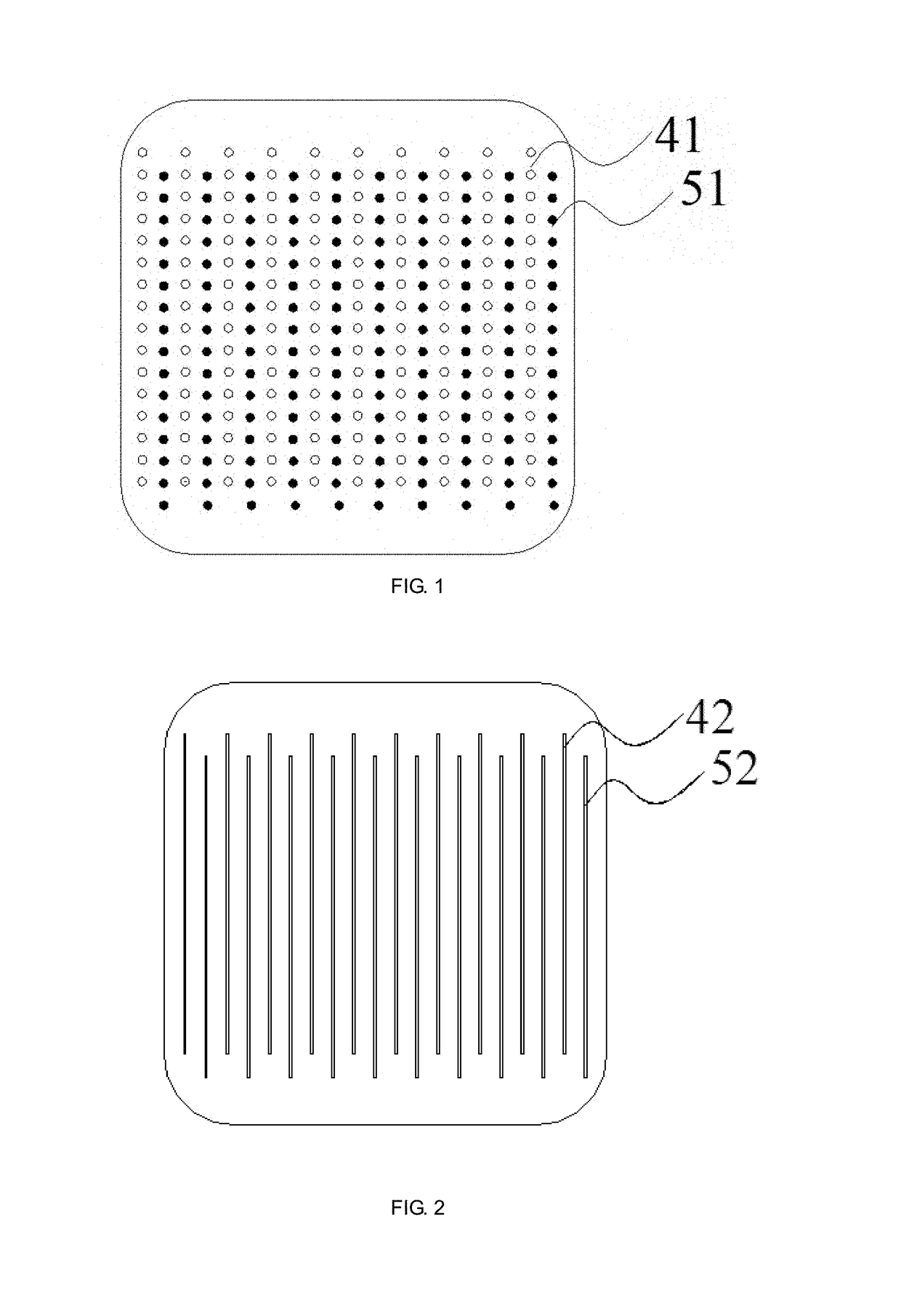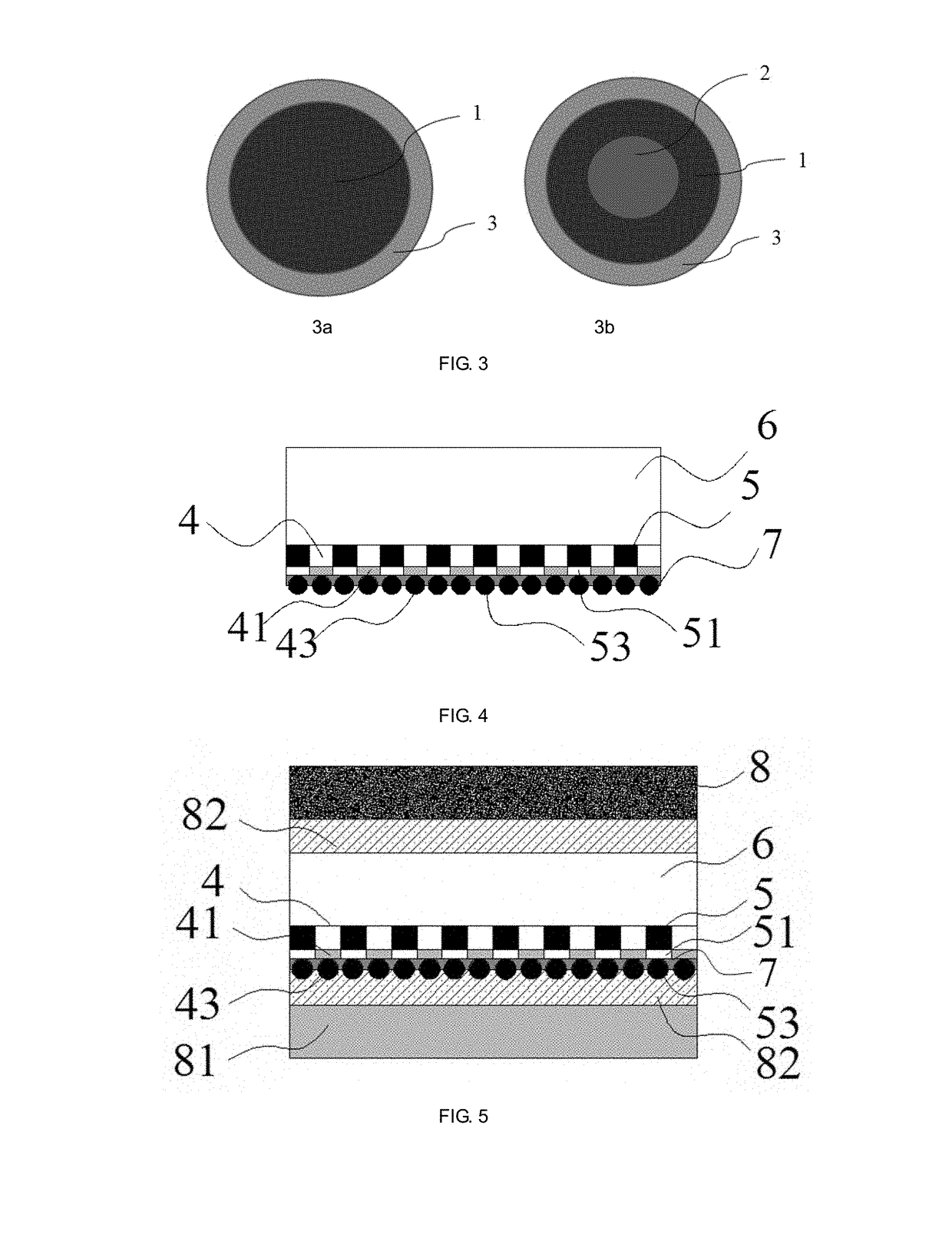Main-gate-free and high-efficiency back-contact solar cell module, main-gate-free and high-efficiency back-contact solar cell assembly, and preparation process thereof
a solar cell and back-contact technology, applied in the field of solar cells, can solve the problems of reducing the effective light-receiving area affecting the efficiency of the solar cell, so as to reduce the electron collection distance, reduce the series resistance of the assembly, and simplify the preparation process
- Summary
- Abstract
- Description
- Claims
- Application Information
AI Technical Summary
Benefits of technology
Problems solved by technology
Method used
Image
Examples
embodiment 1
[0069]As shown in FIG. 1 and FIG. 4, a main-gate-free and high-efficiency back-contact solar cell module comprises cells and an electrical connection layer. The cell comprises a N-type monocrystal silicon substrate 6, the back side of which has P-electrodes connected to a P-type doping layer 5 and N-electrodes connected to a N-type doping layer 4, with a thermoplastic resin or thermosetting resin being provided at an insulating layer 7 between the P-electrodes and the N-electrodes. Wherein, the P-electrodes are dotted P-electrodes 51, and the N-electrodes are dotted N-electrodes 41; the dotted P-electrodes 51 and the dotted N-electrodes 41 are arranged alternately; and there are total 2080 dotted P-electrodes 51 and dotted N-electrodes 41. The diameter of the dotted P-electrodes 51 is 0.8 mm, and the distance between two adjacent dotted P-electrodes 51 is 1.5 mm. The diameter of the dotted N-electrodes 41 is 0.7 mm, the distance between two adjacent dotted N-electrodes 41 is 1.5 mm,...
embodiment 2
[0082]As shown in FIG. 1 and FIG. 4, a main-gate-free and high-efficiency back-contact solar cell module comprises cells and an electrical connection layer. The cell comprises a N-type monocrystal silicon substrate 6, the back side of which has P-electrodes connected to a P-type doping layer 5 and N-electrodes connected to a N-type doping layer 4, with a thermoplastic resin or thermosetting resin being provided at an insulating layer 7 between the P-electrodes and the N-electrodes. As shown in FIG. 1, the P-electrodes are dotted P-electrodes 51, and the N-electrodes are dotted N-electrode 41; the dotted P-electrodes 51 and the dotted N-electrodes 41 are arranged alternately; and the total number of dotted P-electrodes 51 and dotted N-electrodes 41 is 24200. The diameter of the dotted P-electrodes 51 is 0.5 mm, and the distance between two adjacent dotted P-electrodes 51 is 1.4 mm. The diameter of the dotted N-electrodes 41 is 0.4 mm, the distance between two adjacent dotted N-electr...
embodiment 3
[0095]As shown in FIG. 2 and FIG. 4, a main-gate-free and high-efficiency back-contact solar cell module comprises cells and an electrical connection layer. The cell comprises a N-type monocrystal silicon substrate 6, the back side of which has a P-type doping layer 5 and a N-type doping layer 4, with linear P-electrode regions 52 are formed on the P-type doping layer 5, linear N-electrode regions 42 are formed on the N-type doping layer 4, and the linear P-electrode regions 52 and the linear N-electrode regions 42 are alternately arranged. The width of the linear P-electrode regions 52 is 0.7 mm, and the distance between adjacent linear P-electrode regions 52 is 1.5 mm. The width of the linear N-electrode regions 42 is 0.5 mm, the distance between adjacent linear N-electrode regions 42 is 1.5 mm, and the center distance between the linear P-electrode regions 52 and the linear N-electrode regions 42 is 2.0 mm. The conversion efficiency of the cell is 20.5%. An insulating layer 7 is ...
PUM
 Login to View More
Login to View More Abstract
Description
Claims
Application Information
 Login to View More
Login to View More - R&D
- Intellectual Property
- Life Sciences
- Materials
- Tech Scout
- Unparalleled Data Quality
- Higher Quality Content
- 60% Fewer Hallucinations
Browse by: Latest US Patents, China's latest patents, Technical Efficacy Thesaurus, Application Domain, Technology Topic, Popular Technical Reports.
© 2025 PatSnap. All rights reserved.Legal|Privacy policy|Modern Slavery Act Transparency Statement|Sitemap|About US| Contact US: help@patsnap.com



